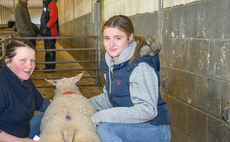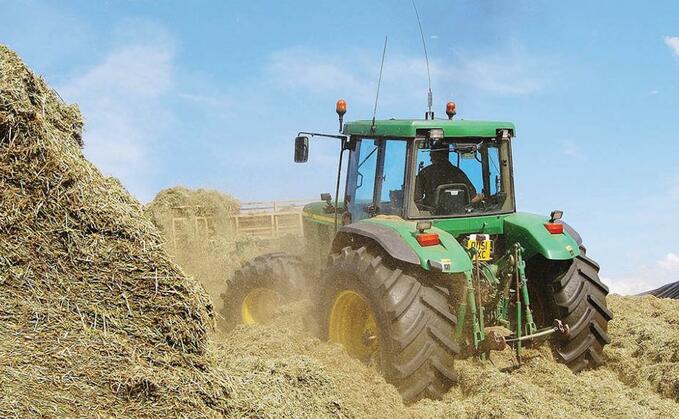
It has been 16 years since the last John Deere 7810 rolled off the production line, yet there are still thousands in service on farms around the world.
Still commanding high resale prices, what is the appeal of these tractors? Simon Henley finds out.
Ashley Davies farms 400 hectares near Atherstone on the North-Warwickshire/Leicestershire border.
He is an advocate of cheap affordable horsepower, and his tractor fleet incorporates a number of older tractors, including an immaculate John Deere 7810 which still plays a crucial role in his beef/arable farming operation. Furthermore, it is a tractor he has no intentions of selling.
When it comes to discussing the pros and cons of John Deere 7810 ownership, there are few people more qualified than Mr Davies.
He has owned his 8,300-hour example since it was new in 2001, and the tractor still averages about 250 hours a year performing cultivation work, bale carting, muck spreading and buck-raking grass during the silage season.
"I bought the tractor to expand our fleet," reveals Mr Davies. "We had taken on some extra contracting work and I needed a more powerful tractor to work alongside our John Deere 7710."
Prior to the arrival of his 7810, Mr Davies had relied exclusively on his John Deere 7710 which was bought in 1997 to replace a Case 2390.
Impressed by the Deere's comfort and all-round performance, the later purchase of a 7810 was essentially a ‘no-brainer', as Mr Davies explains.
"I wanted a 7810 with the 20 by 20 PowerQuad transmission," he recalls. "But the only tractor available at the time featured the new AutoQuad II gearbox, which Deere had just introduced, and the new electronic fuel pump.
"Unfortunately the tractor did not have Triple Link Suspension [TLS], which was not really a problem back then as the 7710 did not have it. In hindsight, I should have opted for TLS, but it has not really been an issue."
Mr Davies' 7710 and 7810 tractors are part of an all-Deere fleet which includes a 3650, 6920, 8420 and an 8520T (see panel). If you are familiar with John Deere tractors, you will immediately recognise all these tractors are ‘old-school' oil burners, built before black exhaust smoke became environmentally anti-social. In fact, the newest tractor on this farm was built in 2006.
One of the key factors Mr Davies presses home about his tractors is everything is meticulously maintained. Besides routine servicing, all his tractors are frequently washed-off and regularly polished. He even recently repainted the wheel rims on the 7810, which is so clean you would think it was just a few years old.
"I will not deny that, from a technological perspective, the 7810 is arguably out of date," says Mr Davies.
"Let us face it, modern tractors offer 50kph continually variable transmissions, high-tech cab and front axle suspension systems, electronic spool-valve controls and touch-screen monitors, arriving GPS and auto-steer ready from the factory.
"In terms of breakdowns, the most significant problem was an engine failure at 2,200 hours which was caused by an injector fault which melted piston number six. The engine was completely rebuilt and aside from a leaking rear main seal last year, it has never had another problem.
"I have to say John Deere were supportive when the engine failed and paid for the parts, even though the tractor was out of warranty.
"A more recent mechanical issue was snap-ring failure on the off-side front axle reduction hub last year. This allowed the sun gear shaft to move inboard, causing serious damage inside the hub. When the thrust washer behind the shaft fell out, it locked the axle solid. This was a £3,000 repair.
"Maintenance-wise, aside from oil changes the tractor has required two new exhaust systems and a new exhaust manifold, which had warped. The exhaust systems typically last about 4,000 hours before they rust out.
"The bit to watch, is the section which runs along the base of the cab above the battery box. If it starts leaking here, the hot exhaust gas will set the batteries on fire.
"The brakes were overhauled at 5,000 hours. We do a fair bit of road work but I am fastidious when it comes to keeping trailer brakes in order. Trailer brakes dramatically reduce the wear on the tractor's brakes and the transmission clutch packs."
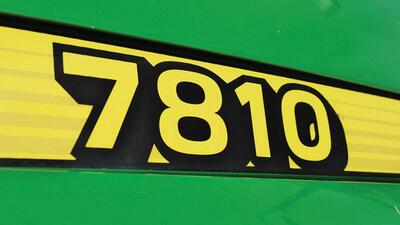
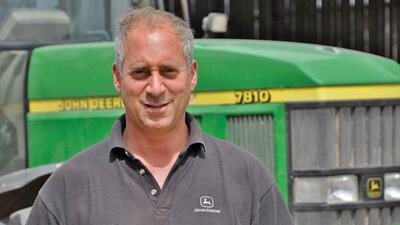
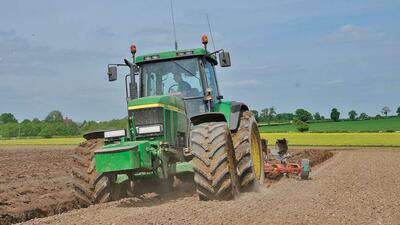
John Deere 7810 specifications
Year: 2001
Engine: John Deere, 8.1-litre, six-cylinder, turbo
Power: 175hp (196hp maximum)
Torque: 870Nm at 1,400rpm
Transmission: AutoQuad II, 20 by 20, 40kph
Hydraulic pump: 100 litres per minute at 200 bar
Weight: 7,423kg (operating)
Wheelbase: 2.9 metres
Turn Radius: 5.1m
Extras: Front linkage
Cost New: £44,500 (on-farm)
MORE
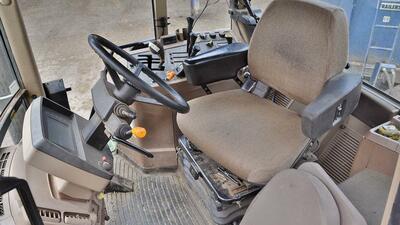
In terms of its operational quality, the 7810 gets a big thumbs up from Mr Davies. He praises the cab for being easy to exit and enter and describes the gear levers and hydraulic controls as being perfectly placed for light, precise operation.
Visibility all-round is excellent and the tractor's push-out Dromone pick-up hitch can be seen from the seat without hanging out the back window.
On the comfort front, while the air-conditioning system - which was overhauled last year - admittedly struggles on exceptionally hot days, the driver's air-seat is noted as being extremely comfortable with a wide range of adjustment suitable for even the tallest operators.
"I rebuilt the seat in this tractor a couple of years ago," says Mr Davies.
"Having a good seat on a tractor like this with no TLS, is a necessity. You never get numb legs or back ache in this seat and it is far superior to the Grammer seat in the 6920.
"I also like the adjustable steering column, which can be set almost perfectly. Unfortunately, the tiny ram which holds the steering column back when it is released and pushed away for climbing in and out the cab has recently failed on our tractor, so the steering wheel drops in your lap. That will be repaired before harvest."
From a performance point of view, the 7810 is rated as a great in-field tractor for trailer work. The high driving position enables the driver to see into a grain trailer and, with the wheels spaced out, the tractor has a surprisingly tight turning circle.
"If I am honest, it is a bit clumsy for extensive road work," states Mr Davies.
more2
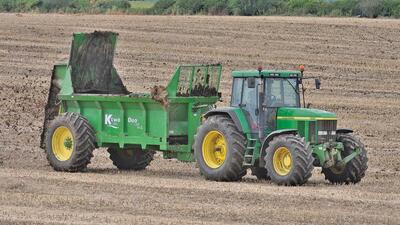
"We recently replaced the tractor's Goodyear boots with a set of BKT tyres, which dramatically improved the ride, but the 6920 will out-pull it with a grain trailer and feels more composed.
"You will not get the best out of a 7810 if you just attach it to the largest implement it can lift. For example, she will pull six-furrows, but it handles a five-furrow plough more comfortably without mauling the engine. The trick is to use the engine's torque. These engines are at their most efficient and economical at about 1,600rpm."
It is not hard to see the appeal of a John Deere 7810. Its timeless good looks, rugged construction, bullet-proof gearbox and generously displaced engine are ingredients in a recipe which has endured for more than 20 years. But every dog has its day, and surely at some point Mr Davies will need to replace his tractors, right?
"The 7710 and the 7810 are not only valuable working assets, they are also appreciating in value. As long as I am working, they will not leave this farm. I still enjoy driving the 7810. If you have never driven a 7810 with the window open, you are seriously missing out on something. The bark from the exhaust when it is pulling hard is truly a wonderful sound."
About John Deeres 7810
Introduced in 1996, the John Deere 7810 was the most powerful tractor in the John Deere 7010 Series, which replaced the 7000 Series with a UK line-up which also offered the 7610 and 7710 models.
Built in Waterloo, Iowa, the 7010 Series featured John Deere's pioneering full-frame modular steel chassis and the company's two-door TechCentre cab, providing a level of ergonomic refinement virtually unequalled at the time.
In terms of styling, the 7010 Series tractors were virtually identical to their predecessors. However, underneath their skin, the new models would gradually introduce a host of new features, including a new 8.1-litre, six-cylinder turbocharged engine and the firm's front axle Triple Link Suspension system.
Designed as a replacement for its venerable 7.6-litre engine, John Deere's 6081 (8.1-litre) power plant proved to be a relaxed performer, providing the 7810 with a generous 870Nm of torque at just 1,400rpm and a power rating of 175hp at 2,100rpm.
Later developments included JD's optional AutoQuad II transmission (2000), AutoPowr hydro-mechanical continuously variable transmission (2001) and an electronically controlled fuel pump which featured a power-boost system increasing power to 196hp for PTO applications or at speeds above 30kph (2001).























